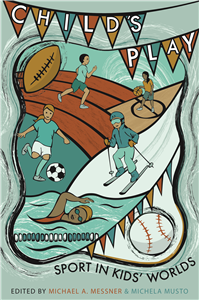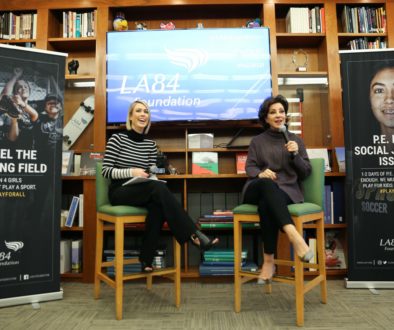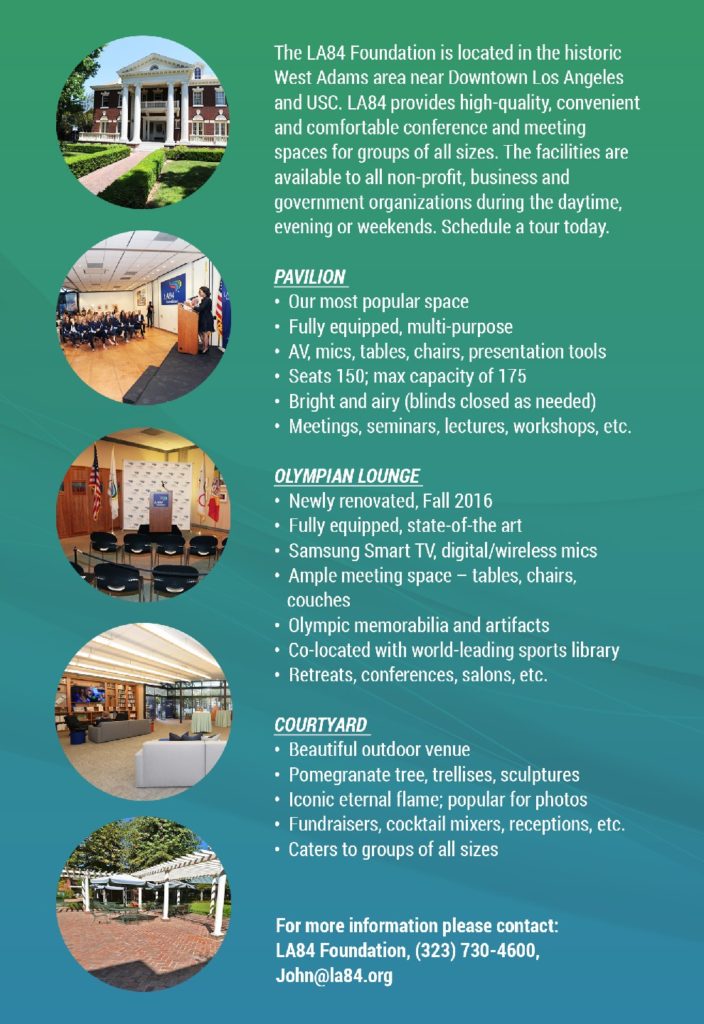SL Interview: Making Children Really Matter In Youth Sports
 Youth sports have become ubiquitous in this country, with vast legions of kids signing up to play AYSO, Little League, Pop Warner, and the like, and with vast legions of parents who drive them to practices, games and tournaments. According to the most recent statistics attributed to the Sports and Fitness Industry Association, more than 26 million children between the ages of 6 and 17 participate in youth sports.
Youth sports have become ubiquitous in this country, with vast legions of kids signing up to play AYSO, Little League, Pop Warner, and the like, and with vast legions of parents who drive them to practices, games and tournaments. According to the most recent statistics attributed to the Sports and Fitness Industry Association, more than 26 million children between the ages of 6 and 17 participate in youth sports.
But academic research on the topic of youth sports has lagged well behind this high rate of participation, according to Michael Messner, professor of sociology and gender studies at the University of Southern California. As he writes in the introduction to his latest book, “Child’s Play: Sport in Kids’ Worlds” (Rutgers University Press), co-edited with Ph.D. candidate in sociology at USC Michela Musto, “scholars of sport have largely ignored kids as active participants — as athletes and fans — and have mostly failed to study the ways in which sport, both for good and for ill, is so often an important and meaningful part of the larger landscape of childhood.”
The book is a hard-hitting salvo that begins to reverse this trend. The 11 essays in the book examine the landscape of youth sports from several perspectives, including inside the kids’ worlds, and analyze such disparate topics as obesity, concussions, and transgender youth. In documenting the paradox of massive youth sport participation and the relative silence among sports scholars about youth, Messner and Musto argue that “a deep and critical research engagement with kids and sport not only will yield insights that are relevant to people’s everyday concerns, but also can contribute to central scholarly questions about embodiments, violence and health, social inequality and mobility in schools, neighborhoods, and families, and consumption and audience reception of mass media as well as engagements with new media.”
Messner is the author of several books, including most recently “It’s All for the Kids: Gender, Families, and Youth Sports” (University of California Press) and “King of the Wild Suburb: A Memoir of Fathers, Sons and Guns” (Plain View Press). “Child’s Play” is the latest volume in the Critical Issues in Sport and Sociology series published by Rutgers University Press. Messner is the co-editor of the series, along with University of Minnesota sociology professor Douglas Hartmann.
SportsLetter recently spoke to Messner by phone.
–David Davis
SportsLetter: How is this book different from your previous books?
Michael Messner: For one thing it’s a collection of current research and articles on youth sports by a group of sports scholars. I’ve edited books in the past, like the ones I co-edited with [D’Youville College professor in Health Policy] Don Sabo, but this one really does focus on primary research about children and youth in sports. My previous book, “It’s All for the Kids,” was about youth sports; it’s right there in the title. But it’s really not about the kids. I wasn’t studying the kids. It was more about the adults and the ways in which adults create gender in youth sports and project it onto the kids.
SL: How did this book come about?
MM: [Co-editor] Michela Musto and I started by writing an article that was published in the Sociology of Sport Journal that morphed into the introduction to the book. She was doing research about kids on a coed swim team and how they relationally create gender. This was her Masters level project that later became a chapter in the book. As she was working on this, we kept remarking on how little research there seemed to be about kids and sports and that the only research out there from sociologists in the field was the larger survey research that Don Sabo and others do. That’s very valuable, of course, but there didn’t seem to be the kind of close-up, ethnographic, participant-observation, interview-based, qualitative research that is so strong in our field when sociologists look at young adults, college athletes and professional players.
We decided that we would, first, survey the field. We looked at the last several years of the major journals and the major book series, all of that, and found that indeed our impression was right. People just weren’t focusing that much on kids. We used the concept of the iceberg: basically, sociologists of sport are focusing on the tip of the iceberg above the water, the levels of sport that everybody sees — college, professional, elite, Olympic and international sport and media coverage of sport — because we watch TV or we’re fans or whatever. Below the surface of the water is this massive participation of kids and youth in sport, and we’re mostly not looking at them.
So, part of our reason for doing the book was to point out that hole, and another part was to bring up a cluster of issues, agendas, and questions that are begging to be studied. Then, we fanned out and looked for people doing interesting work in the field of kids in sports, and we invited them to write pieces for the book. The articles ended up falling into two categories: one half gives the broad picture, with surveys and national data, and then the second half of the book gives close-up studies that look into kids’ worlds in sports.
We really wanted to have pieces that took kids seriously as social actors and didn’t think of them as future adults or as blank slates that adults were pouring information into. We wanted to find pieces that took kids’ experiences and meaning-making seriously — What does sport mean to them and what can sport mean to them?
SL: Why do you think that sociologists have for the most part ignored studying youth sports? Is it because they find it so difficult to set up studies about kids and youth?
MM: If you ask sports sociologists, some of them will tell you that studying kids is problematic because they have to go through institutional review boards, and because there are so many different layers of getting permission to observe and talk to kids. But there’s this burgeoning field of children and youth study, and people are managing to study kids in other fields besides sports. So, I don’t think that excuse holds a lot of water.
I think it has more to do with the fact that there’s an inertia that develops in any field, where we study certain things and then we keep studying the same things. And, I think it has a lot to do with the fact that most sport sociologists are people who grew up as sports fans. When we think of sports, what come to mind are the big-time college and professional sports and the Olympic Games. When we look at the newspaper or the internet, when we watch “SportsCenter,” that’s the coverage we see. That’s what’s on our minds. That’s what we think of as sports, and so that’s what we end up studying.
Also, as we mention in the book, some sports-studies people get funded to do research, just like many other scholars do. Topics involving elite or college sports are probably more likely to get funded for research, whether it’s adherence to Title IX or race in sports. But, again, it seems to me that there should be money to research topics concerning youth in sports, especially given the emphasis on health among kids these days.
SL: What are some of the most dramatic changes that you’ve seen in youth sports since you first began studying the topic?
MM: It depends on the time span you’re talking about. In my lifetime, the biggest change is the mass movement of girls into sports. Sports used to be all for boys and all about boys before, and now it’s normal for girls to participate in sports.
Recently, I think it’s the ways in which sports have been institutionalized in kids’ lives, as part of the larger configuration of extracurricular activities that their professional-class parents are ferrying them around to, from their music lessons to their math coaches to their club sports teams. That often turns out to be more about resume building, or getting into the right college, than the way we might have grown up thinking about sports.
Related to that, there are also concerns that, within more disadvantaged communities, certain kids don’t have access to sports in the same ways that the kids with professional-class parents do. I think that’s become a major concern — how to get kids in underprivileged groups access to sports — which of course is something that the LA84 Foundation has largely been focused on.
Most recently, the debate about health concerns among youth has become an interesting topic. I think there’s a lot of good stuff in the book about that, including the obesity epidemic. The concussion issue is a horrible thing, but it’s also a wonderful opportunity for researchers in terms of studying the way organizations, coaches and families are responding, and speculating about what the implications are going to be for certain sports, especially football, in the future.
SL: Within the realm of youth sports, are there certain topics that you think have been under-reported or under-recognized?
MM: One topic is, kids as consumers and fans of sports. In what ways are kids consuming sports, and what does that mean in terms of the larger texture of their lives? For instance, are kids watching TV broadcasts of games like previous generations did?
Another topic is, looking at how kids make meaning out of being targeted by national and local campaigns that view sports as a way to encourage physical activity and health. One of the chapters in the book is about the NFL’s PLAY 60 program that is a corporate-led marketing campaign [co-written by Jeffrey Montez de Oca, Jeffrey Scholes, and Brandon Meyer]. You could also look at, say, Michelle Obama’s program directed at kids eating healthy and exercising and examine how kids make meaning out of being targeted for this.
Another totally understudied angle is looking at kids who don’t play sports or who drop out of sports or who hate sports or who were humiliated by sports. The policy implications for schools and communities about this topic are so important because if we want kids to get engaged in physical activity early on — because we know that it’s a good predictor of health practices in middle and late adulthood — then we shouldn’t set up situations in schools and after-school programs that alienate significant swatches of kids who hate physical education and competitive sports from getting engaged in physical activity. To me, studying how we can restructure programs to create opportunities for those kids to enjoy physical activity and make it a part of their daily routine is one of the key areas that needs to be researched more. [Western University associate professor of education] Michael Kehler’s piece in the book looks at the issue with Canadian kids and physical education class.
SL: You wrote about that topic in one of your previous books, didn’t you?
MM: Yes, in “It’s All for the Kids,” when I followed my own son from T-ball through 14-year-old Little League. I always think of him when I think of kids dropping out of sports really early — whether it’s soccer, baseball or basketball. He felt exposed because as a kid he just couldn’t develop the skills fast enough to make himself feel like he was fitting in or that he was halfway competent, much less a star. It took him until he was in his mid-20s to develop some kind of exercise regimen where he feels okay about working out and feeling strong in his body.
When you look at sports teams for really young kids – 4-, 5- and 6-year-olds — there are so many teams. For 7 and 8 year olds, lots of teams. But at each successive stage and age group, there are fewer teams and fewer kids playing. Where did they go? What are they doing now? Some of the answer is, they’re going to other activities that they want to do, that are more important to them. But some of the attrition is due to kids feeling that sports is just not fun.
SL: With so much cheerleading about the benefits of youth sports — for health reasons and to combat obesity — is there a danger that we’ve lost sight of what youth sports should be about?
MM: That’s why I love the afterword in the book by [Indiana University sociology professor] William Corsaro. His final statement is, we have to always remember that, when kids are doing these kinds of things, we want them to be enjoying themselves. It’s such a simple thing, but we just seem to forget it.
I think what we see is, it’s often a mix of positive and negative for most of us when we play sports or when we do pretty much any institutional activity. The piece by [University of Minnesota associate professor of public health] Toben Nelson about the obesity epidemic is instructive because he writes about the ways in which youth sports are set up as this panacea for the obesity epidemic. But then he shows that, oftentimes, we feed our kids these snacks that are way more caloric than the calories they’re supposedly burning off while standing out in the field at a baseball game. That rang so true to me in terms of my kid’s Little League experience, with people bringing boxes of pizza and stacks of greasy burgers and fries for the kids to eat at the end of the game. That’s the kind of thing that parents, league officials, and organizations can learn from.
SL: How is it that obesity among youth is on the rise and yet so is the participation in youth sports? What, if any, is the connection between the two?
MM: I’ve been fascinated by this issue. It’s not something I’ve studied directly, but it’s an issue that’s really big in the field of sports studies. There are these two camps that just don’t talk to each other. In one camp is what I’d call interdisciplinary cultural studies people. You can see some of this in the Michelle Obama campaign, where they’re trying to empower individual kids to make the right choices. Then you have the people who are more into epidemiology, who are looking at the specific kind of empirical links about, over time, the rise of obesity and BMI [body mass index] and diabetes among youth. They tend to advocate getting kids off their couches and away from their screens and into physical activity.
Now, these two groups don’t talk to each other. They operate from very different theoretical perspectives and orientations toward empirical research. I think they’re both right in a lot of ways. That’s the thing that’s so important. I’d love to see more of a conversation between the two because the rise in obesity is a problem related to the current and future health prospects of a whole lot of young people.
But positing youth sports as a panacea for all these health problems is similar to what Doug Hartmann has written about in his essay about midnight basketball. It was easy back in the 1990s for people on both sides of the political aisle, Republicans and Democrats, to get behind midnight basketball as a way out for at-risk kids, because it was designed to get kids off the streets, keep them away from gangs, and get them into something healthy under adult supervision. The problem is, in those communities there’s also poverty and lack of hope and crumbling schools and no jobs and crappy housing. These are institutionalized problems that you can’t solve by opening up a gym for basketball a couple nights a week. It’s not bad for them, but it’s not going to solve the bigger problem.
The youth sports and obesity issue is kind of a similar thing. Youth sports seems to be this one-size-fits-all solution, but we have to careful about how much we can put on the shoulders of sports. No question, it’s good when kids get out and they’re physically active, but that doesn’t come close to getting at the root causes of bigger societal issues. The question is, do we as a society have the political will to deal with this?
SL: One chapter in the book made the point that playing sports is healthy but that becoming too highly involved as an athlete can be unhealthy. How do you explain that?
MM: That’s one of the very interesting findings from the national research that Don Sabo and his colleagues have done. In their surveys, they looked at not just whether kids play sports or not, but how many sports they play and how invested they are in having an athlete identity. They’re finding a clear correlation between positive health and social outcomes for kids who play some sports. But with kids who are heavily invested in being a star athlete — where their parents have them going to private coaches and focusing in on one sport, say, to get a college scholarship — those health and social benefits seem to evaporate. In fact, what you see are risk factors coming in. The journalist Mark Hyman has written about the problems of stress-related fractures and other injures that kids develop because of repetitive motion. There’s the stealing away of time from activities that might broaden the experience of a child, rather than specializing in one sport or one activity. And then, when the kids move up to high school and become even more serious, you have that syndrome of these elite athletes getting so focused on their success they may downplay their academic and social lives. That leads to other research questions: under what conditions and for whom can a specific kind of sports experience be positive or negative — and how do we maximize the positive experience?
SL: The topic of gender came up often in the book. Is there a big difference between girls and boys in terms of youth sports participation these days?
MM: To me what’s more striking is how much more similar the girls’ and the boys’ approaches have become. Girls’ participation has become ubiquitous, and girls feel like they have the right to play sports. They want to play sports, and their parents think they should play sports because it’s good for them.
There’s still not as good access for some girls for some sports. There are certain sports where we have segregation that develops early on, like with the funneling of girls into softball and away from baseball. Don Sabo’s data has shown that, over time, boys are still playing more and girls are dropping out sooner, so there’s still that issue of early adolescent attrition among girls. I think we still tend to encourage boys more, but to me the more striking thing is the convergence of attitudes about sports between girls and boys and families with respect to their sons and daughters.
SL: In talking about health issues, you mentioned the controversy over head trauma and concussions – primarily in football, but also in girls soccer and other sports. How has that discussion influenced the direction of youth sports and the study of youth sports?
MM: I think the medical research about concussions is getting more and more definitive and more and more public. We’re getting a clear sense of the health and medical dangers from concussions. What’s interesting to me is how the issue of concussions brings all these tensions and contradictions and issues involving race and class in sports to the foreground. I don’t know how this will play out, but to me what’s interesting is, how are sports organizations responding to this and how are families responding to this?
You can’t change the rules and the equipment of football in ways that are really going to keep head injuries from happening. It wouldn’t be football any more if they weren’t having collisions at high speeds. As Montez de Oca points out in the book, big organizations like the NFL are trying to manage this as best they can in ways that facilitate the reproduction of the sport and the multi-gazillion-dollar industry that sport is. With the NFL’s Play 60, they’re marketing the organization and its place in the community by using their corporate social responsibility wing, as opposed to direct marketing, to ensure the long-term survival of the business.
Part of that is getting new consumers and new players. Don Sabo tells this story about being a college football player and getting injured. The coach walks out and says, “Get this guy out of here and get a new body in here!” That’s what it’s about for college football and the NFL: they have to get fresh bodies coming in every year.
What I’m interested in is how families are responding to that. The research that we cite in the book shows that there’s a growing proportion of families saying they wouldn’t allow their sons to play football. President Obama has said that, and former NFL players have said that. When you break down that by class, you find that disproportionately the people who are saying they wouldn’t let their kids play football are professional-class families. Poor and working-class families aren’t saying that as much.
You know, the response from the public [about the dangers of football] often is, “Well, they choose to do that, and they get paid lots of money.” But we know that very few football players actually end up getting paid a lot of money and they don’t get paid for very long. What we’re looking at 20 years from now is, the sons of working-class and poor families are going to be paying the price disproportionately for our dubious entertainment.
SL: The articles in the second half of the book bring the voices of kids to the fore. Why is it so important to let kids speak for themselves?
MM: When you’re doing an ethnography, like in the chapter that Michela Musto did at the swimming pool, you can learn things that you can’t get from doing what people often call empirical research. She spent several months on a daily basis watching and then interviewing the kids, and she got this trove of qualitative research that’s deep and narrow. It’s a deep form of immersion and investigation. That’s very different from, say, surveying several thousand people, where the data you get may be broad, but it’s shallow.
It’s so important because, in the case of youth sports, we just haven’t really looked at that aspect much. We have a pretty decent picture of who plays what and who doesn’t. We have a pretty decent picture of what the correlates are regarding social mobility, health, risk-taking, and those sorts of things. But we don’t understand the mechanisms because in order to understand the mechanisms, you actually have to watch it happen and then talk to people. And, particularly when we’re thinking about kids, the assumption that we have that kids are just future adults — that they’re not meaning-making subjects in their own right — that assumption’s been challenged a lot in the general field of children and youth studies, but it hasn’t come over to sports sociology very much. It’s so important for us to think about kids in terms of the meaning that they make, including the ways that sports might impact their identities, their health practices, their relationships with other people, their attitudes about gender and race. Some of that you can probe into with survey research, but you also need to look close-up and listen to the kids’ voices, watch what they do, and try to understand their world as best as you can from the point of view of an adult. You’re not one of them, but you can get close enough to get some insights.
SL: Another topic that has emerged in the news, thanks to people like Caitlyn Jenner, involves the transgender population. What barriers do transgender kids face with their participation in sports?
MM: [Simon Fraser University associate professor of sociology] Ann Travers is right on the cutting edge of this breaking-news issue with her essay about transgender and gender non-conforming kids and how they impact youth sports. Our schools are starting to have to deal with this — middle schools, high schools, even grammar schools. We used to allow other people to bully them and try to force them into one category or another. But the culture is changing pretty rapidly with respect to that, and it’s becoming all about breaking down the binaries.
We’re in a transgender moment right now, and one of the fascinating places to look at that is in sports because it is one of the few institutions we have that is still almost entirely sex-segregated. We let really little kids play on sex-integrated teams, but most sports teams, from youth sports all the way up to the pros, there’s this clear divide between boys and girls, men and women. So, what do you do with people who are gender non-conforming? What do you do with people who are transgender? What do you do with intersex people, like when the issue involving [South African track star] Caster Semenya came up a couple of years ago? It just throws a knuckleball at the whole sex-segregated enterprise of sports.
What’s interesting about Travers’ piece is that she’s looking at the ways families, and especially parents, are helping their kids navigate this system and accessing and exerting their own influence on these organizations. We need to ask ourselves: with the growing presence of gender non-conforming kids, are we just going to repel those kids out of the system? Or, are we going to think carefully about how our youth sports organizations are set up and figure out new rules to accommodate these kids so that everybody feels as though they’re welcome? I think that’s the key question at the center of Travers’ research.
Fundamentally, it’s about re-thinking the assumptions we make about the differences between boys and girls, which are not nearly as wide as we think they are. We have made tremendous strides in thinking about girls in the society and widening the fields for girls and thinking about different ways in which girls can be in the world. We haven’t really thought much about changing the way we raise boys. There’s a very, very narrow way that we still treat boys and think about boys, and I think the growing awareness of transgender kids is a new opportunity for us to re-think gender in a lot of different ways, but especially as it pertains to the narrow assumptions we have about boys.
SL: What other topics regarding youth sports are also ripe for study?
MM: There’s a really wonderful piece in the book about East African teenage girls playing sports in Minnesota [co-written by Chelsey Thul, Nicole LaVoi, Torrie Hazelwood, and Fatimah Hussein], and I think there’s a lot of new research that could be done about immigrant kids and sports. I think it would be great to do here in Southern California. Just thinking about the scene in Southern California: there are so many new Asian groups here. We’ve also become a predominantly Latino community in Southern California, and there are immigrants from Mexico and Central America, first-generation kids and their families, who are new here. It’ll be interesting to see how they integrate into our existing youth sports system in schools and communities, and if they feel comfortable or drawn to it or not, and what they might bring to the table. I wonder just how many of these immigrant kids are below the tip of the iceberg, so to speak, of mainstream youth sports in our society.
Read more SportsLetter interviews here.




